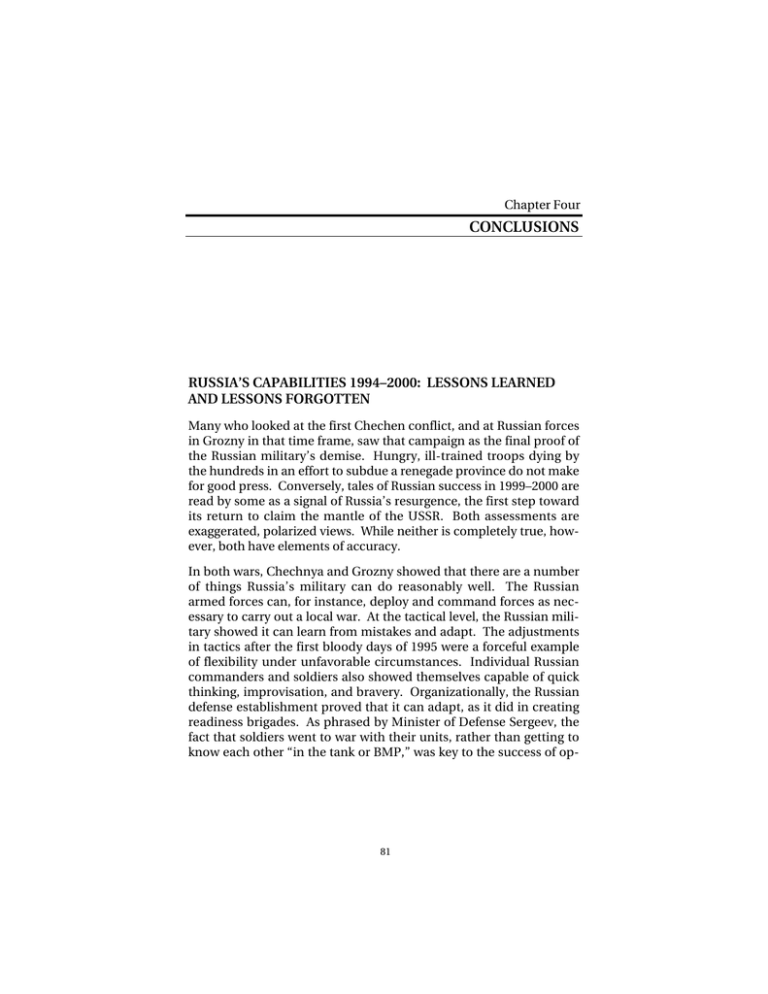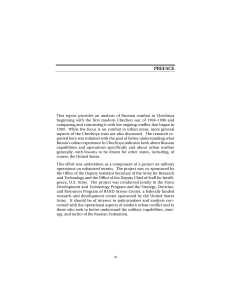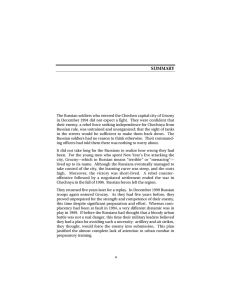CONCLUSIONS RUSSIA’S CAPABILITIES 1994–2000: LESSONS LEARNED AND LESSONS FORGOTTEN
advertisement

Chapter Four CONCLUSIONS RUSSIA’S CAPABILITIES 1994–2000: LESSONS LEARNED AND LESSONS FORGOTTEN Many who looked at the first Chechen conflict, and at Russian forces in Grozny in that time frame, saw that campaign as the final proof of the Russian military’s demise. Hungry, ill-trained troops dying by the hundreds in an effort to subdue a renegade province do not make for good press. Conversely, tales of Russian success in 1999–2000 are read by some as a signal of Russia’s resurgence, the first step toward its return to claim the mantle of the USSR. Both assessments are exaggerated, polarized views. While neither is completely true, however, both have elements of accuracy. In both wars, Chechnya and Grozny showed that there are a number of things Russia’s military can do reasonably well. The Russian armed forces can, for instance, deploy and command forces as necessary to carry out a local war. At the tactical level, the Russian military showed it can learn from mistakes and adapt. The adjustments in tactics after the first bloody days of 1995 were a forceful example of flexibility under unfavorable circumstances. Individual Russian commanders and soldiers also showed themselves capable of quick thinking, improvisation, and bravery. Organizationally, the Russian defense establishment proved that it can adapt, as it did in creating readiness brigades. As phrased by Minister of Defense Sergeev, the fact that soldiers went to war with their units, rather than getting to know each other “in the tank or BMP,” was key to the success of op- 81 82 Russia’s Chechen Wars 1994–2000: Lessons from Urban Combat erations. 1 Better training for specialized forces and for troops destined for mountain combat, as well as all-round better preparation, no doubt had a significant impact. Joint operations exercises involving various forces and services also made a difference. Perhaps even more important were the mutually supportive roles laid out for ground forces, MVD, and other troops as well as for their subcomponents, and the fact that all of them reported to a single commander. All these factors testify to the Russian military’s ability to make real changes. The increased effectiveness they fostered demonstrates that Russia is capable of real military reform. But if the Russian military can learn and adapt in both the short and long term, it seems to have more trouble in the intermediate term. While forces on the ground responded to the situation around them, and careful study yielded significant changes over the interwar period, the Russians seemed to forget painfully learned lessons from one battle to the next. If Russian urban fighting ability improved during the first battle for Grozny, leaders were unable to transfer that knowledge to those who had to defend the city a few short months later. They were able to capture the well-defended city again half a decade later, but they seemed to have forgotten everything they had learned about enemy fortifications and tactics by the time they entered the town of Komsomolskoye. Furthermore, if the Russians improved on some aspects, they ignored others. Due to a lack of training and equipment, most Russian forces cannot fight effectively at night. They continue to have trouble with secure voice communications. Aging and decrepit equipment is an ever-increasing problem. Time and again, they failed in basic military skills, such as carrying out reconnaissance to determine enemy strength. This problem was highlighted in Grozny in 1994, 1996, and 1999, as well as in Komsomolskoye in 2000. If training and equipment remained a problem, planning in 1999– 2000 was much improved. There was a reasonable war plan for Grozny (albeit one based on expectations of a much lower level of resistance than proved to be the case). The Russian military learned from its own mistakes, history, and its enemy in switching to and ______________ 1 Falichev, “Officers’ gathering.” Conclusions 83 planning for small-unit tactics. Combat in Grozny in 1999–2000 benefited tremendously from new approaches to force protection. While armor protection proved more effective than did the effort to avoid close combat through heavy artillery use, the fact that such issues had been considered is an important indicator of the sort of planning that had been absent five years before. Unlike in 1994– 1995, force ratios reflected the terrain and the conflict. The Russians recognized the disadvantages of being the attacker and increased their forces accordingly (although their failure to estimate enemy strength accurately meant that the ratios in Grozny still fell short of those prescribed by Soviet World War II doctrine). In stark contrast to 1994, the troops who entered Grozny in 1999 were a sizable force, reasonably well-supplied, that had the benefit of better training. A unified chain of command ensured that air and artillery support would be forthcoming and that different forces knew their missions. Most important, they had a plan for capturing Grozny, and they had commanding officers whose orders were clear on the need to avoid casualties. Another success of 1999–2000 was a direct outgrowth of what the Russian leadership saw as a failure of 1994–1996. Control of the press this time around was stringent, and the Russians got their side of the story out. The high public approval ratings for the war as it continued bore out the benefits of this approach. While over time the media became increasingly dissatisfied with the situation, and criticism emerged at home and abroad, the fact is that the Russian defense establishment ran an effective media campaign, one largely in keeping with a modern military force seeking to safeguard the details of its operations. There is no question that Russia also had an interest in minimizing any reports of failure, of higher-than-expected casualties, or of human rights violations, but that, too, is not unusual for a modern military embarking on a campaign (although the extent of both casualties and human rights violations reported in the second Chechnya campaign still remained well above levels that most Western militaries might tolerate). Insofar as was possible in a society that at the time enjoyed a relatively free press, the Kremlin and the Ministry of Defense did quite well in maintaining support for the 1999–2000 Chechnya campaign. If in 1994–1996 the military campaign in Chechnya in general and Grozny in particular demonstrated the deterioration of the Red Army 84 Russia’s Chechen Wars 1994–2000: Lessons from Urban Combat from its days of glory, the conflict in 1999–2000 equally clearly demonstrated that reports of Russia’s military demise had been, to paraphrase Samuel Clemens, premature. The Russian armed forces were able to deploy, reinforce, and supply a corps-sized force to fight a significant local conflict. They could plan and carry out plans effectively. Despite some problems, the Russian armed forces showed proficiency in combined arms operations. Finally, and most important, both in 1994 and all the more so in 1999, Russia was able to demonstrate that despite their scanty training and limited military education, its soldiers, marines, and airmen could still engage in combat effectively. LEARNING FROM THE RUSSIAN EXPERIENCE In spite of the better planning, improved training, reasonably effective force coordination, and a successful media campaign, Russian forces took heavy casualties in Grozny and, through their tactics, virtually destroyed the city. Even then, it is unclear whether the rebels’ retreat was a result of genuine Russian victory or of previously laid guerrilla plans. Thus, whatever else the Russian army proved itself capable of in Chechnya and Grozny over the last five years, it could not and cannot bloodlessly and effectively capture a large urban area from an insurgent force. One reason for this limitation is that in 1999, as in 1994, the Russians were fundamentally unprepared for urban combat. Forces practiced for mountain combat, for small-scale counterterrorist actions, even for urban defense, but not for capturing a populated area by force. True, the Russians developed real plans and paid some attention to training their soldiers. They also made careful and seemingly effective preparations for the attack, including encircling and cutting off the city. But the plans once again failed to take into account the possibility of real resistance, and most of the training the soldiers received took place on the outskirts of Grozny itself only days before they were sent in. Moreover, despite all efforts, the encirclement proved porous. Why, in preparing for a second large-scale Chechnya war, did the Russians fail to prepare for a second major battle for the city of Grozny? On the basis of the evidence assembled in this report, the failure stemmed from the Russians’ fervent hope of not needing to Conclusions 85 engage in another round of urban combat. All other lessons aside, the one thing the Russians had truly learned from the nightmare of 1994–1995 was that urban combat was to be avoided at all costs. Fighting in a city was difficult, bloody, and very manpower-intensive. It was the quickest way possible to send hundreds of body bags home to Russian parents. It was the most difficult and unlikely way imaginable to attain the sort of quick military success that played well in the media and with the electorate. The Russian military leadership therefore decided to avoid close combat altogether. Its forces would instead bypass towns and make deals with village elders. They would shell Grozny, and any smaller towns that proved recalcitrant, into submission. They soon found that this approach was flawed. The Russian military was unable to avoid urban combat in Grozny, Komsomolskoye, and a range of smaller towns. 2 Because the Russians so feared urban combat, and were so determined to avoid it, they were largely unprepared for it when it came. In 1994 the Russians had ignored all evidence that a Chechen resistance remained in Grozny. In 1999 they convinced themselves that weeks of aerial bombardment had driven the rebels out.3 The guerrillas purposely made it appear that way; certainly it was in their interests to draw the Russians into a city where significant resistance remained and the rebels could do what they did in 1994. The result was similar: significant Russian casualties and a drawn-out battle to capture and hold every block of territory. The Russians faced a very difficult enemy in Chechnya. An insurgent force on its home territory is a very different thing from a conventional army. The enemy can melt back into the population. Village elders can lie when they assure troops of their town’s loyalty. Most important, because the two sides are fighting very different wars, the insurgents have an easier template for victory. The Russians had to win and hold territory. The Chechens just had to make doing so sufficiently painful that their enemy would give up the task. ______________ 2 Korbut, “The Kremlin and the armed forces are learning their lessons.” 3 Golz, “Front to the rear.” 86 Russia’s Chechen Wars 1994–2000: Lessons from Urban Combat The urban dimension makes things even more complicated, combining the advantages of insurgency with those of defense. Sealing off a city, with its many streets and underground passageways, is difficult even for planners who know it well, and it consumes vast amounts of manpower. Surrounding the city is not enough. And once fighting begins, its complex terrain of streets, buildings, and other structures provides every advantage to the defender who knows his city. In Grozny, furthermore, the rebels were able to augment these advantages with modern technology. The small groups of rebels moved rapidly underground and through the lower stories of buildings, using hand-held radios to keep in constant contact with their leaders. As a result, the rebels had a far clearer sense of the battlefield than did the Russians, and even with overwhelming numbers and overwhelming firepower, the Russians were able to attain their questionable victory only with high casualties and only by destroying much of the city. How, then, can a modern and capable force train for such contingencies? A careful study of the tactics of both sides in Grozny is an excellent start. A commitment to training forces for a wide range of contingencies in built-up areas is equally imperative. Understanding the advantages of the defense is essential. The biggest mistake one can make is the one the Russians made between 1996 and 1999: By believing that they could avoid urban battle by not preparing for it, the Russian military guaranteed that any fight, successful or otherwise, would have a very high cost.







